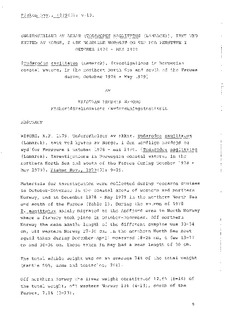| dc.description.abstract | Materials for investigation were collected during research cruises
in October-November in the coastal areas of western and northern
Norway, and in December 1978 - May 1979 in the northern North Sea
and south of the Faroes (Table l), During the autumn of 1978 T.sagittatus
mainly migrated to the Andfjord area in North Norway
where a fishery took place in October-December. Off northern
Norway the mean mantle length of the different samples was 33-34
cm, off western Norway 27-30 cm. In the northern North Sea most
squid taken during December-April measured 18-28 cm, a few 13-17
cm and 30-36 cm. Those taken in May had a mean length of 30 cm.
The total edible weight was on an average 74% of the total weight
(mantle 50%, arms and tentacles, 24%) .
Off northern Norway the liver weight constituted 12,6% (6-16) of
the total weight, off western Norway 10% (4-13), south of the
Faroes, 7.1% (3-13) .
Males are easily distinguished macroscopically by the condition of
the skin, becoming ragged and slimy very soon after capture, while
the females keep their skin firm and smooth.
Off northern Norway males constituted 8-25% of the stock, off
western Norway 4%. In the North Sea nearly as many males as females
were caught in December-April (10 male, 13 female) in May at the
Faroes, 30% were males. It is suggested that males are less willing
to take the hooks than the females.
All females taken were immature. In two males, mantle lengths 31
cm and 36.5 cm, caught in the North Sea in December, the gonads
weighed 7.2 and 13.0 g respectively, i.e. 2.0 and 1.0% of the
total weight. At the Faroes the gonads of the males were more or
less in an advanced stage of development, constituting 0.5-2.0%
of the total weight.
Food items in the stomachs were dominated by fish, off northern
Norway saithe, herring and redfish, at the Faroes blue whiting.
Euphausiids ranged second, squid third. It is suggested that the
high percentage of squid recorded earlier (WIBORG 1972, 1978) may
partly be an artifact, as arms and tentacles are torn off during
the fishery and then eaten by the squid.
Following LIPINSKY (1978), ageing of squid was attempted in studying
the statholiths under a microscope after grinding. Rings,
supposed to be daily growth rings, were seen, and countings seem
to confirm the earlier hypothesis (WIBORG 1972) of two populations
of T. sagittatus, spawning during December-January and May-July
respectively.
Location of squid with echo sounders and fishing experiments with
Japanese jigging machines were successful. T. sagittatus is now
readily accepted for human consumption. | en |
